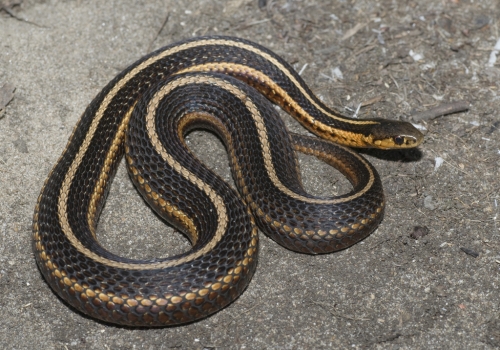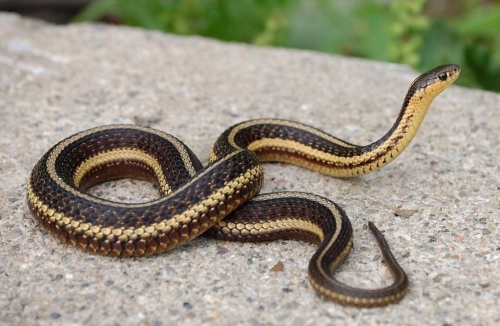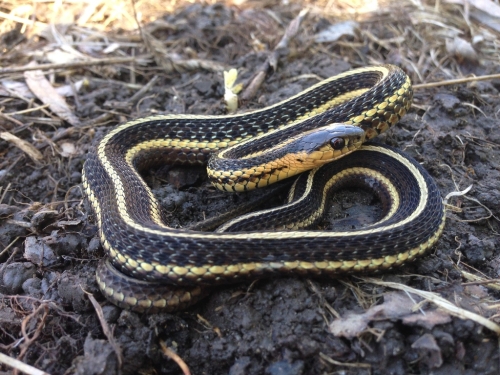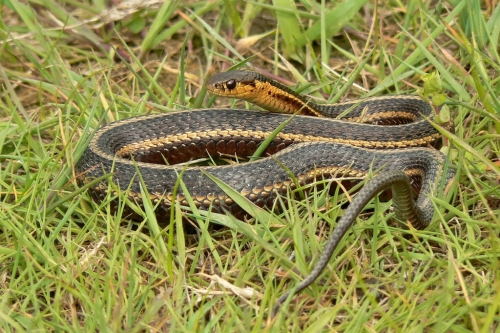Plants and Animals
Thamnophis butleri Butler's garter snake
Key Characteristics
Butler's Garter Snakes are small (adult lengths of 38.1 to 73.6 cm), stout-bodied garter snakes with three well-defined yellow, orange-, or cream-colored stripes that run along the length of their body. The body is black, brown, or olive-brown in color. These snakes sometimes have two rows of dark or black spots running down their back between the central stripe and the two side stripes. The two lateral stripes on the sides of the body are centered on scale row 3 and adjacent halves of scale rows 2 and 4. This characteristic distinguishes this species from the Eastern Gartersnake (include scientific name), which has side stripes restricted to scale rows 2 and 3, and the Northern Ribbonsnake (include scientific name), which has side stripes only on rows 3 and 4. Butler Garter Snakes are characterized by bellies that are pale green or yellow and edged with brown, with black spots and running along the edges. Their head is black or olive, often with two tiny yellow spots on the large scales at the back of the head. Their head is small and relatively narrow, not much wider than their body. This is in contrast to Eastern Gartersnake and Northern Ribbonsnake, which both have larger, longer heads. Butler Garter Snakes have 19 (occasionally 20-21) scale rows at midbody, and 7 upper labial (lip) scales. Their scales are keeled (with a ridge along the length of the scale), and they have a single, undivided anal plate or scale that covers their cloaca or anal opening.
Status and Rank
US Status: No Status/Not Listed
State Status: SC - Special Concern (rare or uncertain; not legally protected)
Global Rank: G4 - Apparently secure
State Rank: S4 - Apparently secure
Occurrences
| County | Number of Occurrences | Year Last Observed |
|---|---|---|
| Alpena | 2 | 1957 |
| Arenac | 1 | |
| Barry | 1 | 1960 |
| Clinton | 3 | 2022 |
| Eaton | 1 | 1967 |
| Genesee | 1 | 2021 |
| Gratiot | 1 | 2006 |
| Ingham | 4 | 2018 |
| Lapeer | 2 | 2021 |
| Monroe | 1 | 2017 |
| Osceola | 1 | 1962 |
| Presque Isle | 1 | 2020 |
| Saginaw | 1 | 2018 |
| Sanilac | 1 | 2020 |
| Shiawassee | 2 | 1969 |
| St. Clair | 1 | 2018 |
| Tuscola | 1 | 2012 |
| Washtenaw | 2 | 2023 |
| Wayne | 3 | 2021 |
Information is summarized from MNFI's database of rare species and community occurrences. Data may not reflect true distribution since much of the state has not been thoroughly surveyed.
Habitat
Habitat for this species consists of open or semi-open wetlands, including wet meadows and prairies, marshy edges along lakes, ponds, and streams, and other moist grassy/sedgy areas, and adjacent open/semi-open canopy upland habitats. This species also occurs along railroad embankments and roadsides and in vacant lots and old dumps in urban and suburban areas. It prefers short vegetation (<60.1 cm), although they will occupy habitats with taller vegetation, such as wetlands dominated by reed canary grass. Dense grass cover with a heavy thatch layer is essential to its habitat, as the thatch layer allows this snake to move around in search of food under cover from predators. Butler Garter Snakes spend much of the active season below ground or under vegetation or shelter of cover objects including logs, rocks, debris on the ground, burrows, ant mounds, old house foundations, and other similar microhabitats. Birthing or parturition habitat consists of lowland areas or wet depressions surrounded by higher and drier land. Drier areas typically include shrub or tree cover along the edges of wet depressions and may include wetland indicator plant species typically found in swamps and marshes. Butler Garter Snakes overwinter below ground in small mammal or crayfish burrows (e.g., Devil’s Crayfish, Cambarus diogenes), drains, log piles, loose soil of ant mounds, and other underground sites.
Natural Community Types
- Coastal fen
- Dry sand prairie
- Dry-mesic prairie
- Emergent marsh
- Floodplain forest
- Great lakes marsh
- Interdunal wetland
- Lakeplain oak openings
- Lakeplain wet prairie
- Lakeplain wet-mesic prairie
- Mesic sand prairie
- Northern fen
- Northern wet meadow
- Oak barrens
- Oak openings
- Prairie fen
- Rich tamarack swamp
- Southern shrub-carr
- Southern wet meadow
- Wet prairie
- Wet-mesic prairie
For each species, lists of natural communities were derived from review of the nearly 6,500 element occurrences in the MNFI database, in addition to herbarium label data for some taxa. In most cases, at least one specimen record exists for each listed natural community. For certain taxa, especially poorly collected or extirpated species of prairie and savanna habitats, natural community lists were derived from inferences from collection sites and habitat preferences in immediately adjacent states (particularly Indiana and Illinois). Natural communities are not listed for those species documented only from altered or ruderal habitats in Michigan, especially for taxa that occur in a variety of habitats outside of the state.
Natural communities are not listed in order of frequency of occurrence, but are rather derived from the full set of natural communities, organized by Ecological Group. In many cases, the general habitat descriptions should provide greater clarity and direction to the surveyor. In future versions of the Rare Species Explorer, we hope to incorporate natural community fidelity ranks for each taxon.
Management Recommendations
Maintaining and protecting suitable wetland and adjacent upland habitats within and around extant populations are critical to conservation of this species. Urban, commercial, and industrial development as well as conversion of habitat to agricultural land have resulted in significant habitat loss and degradation. Minimizing the use of pesticides within and adjacent to occupied habitats would help maintain sufficient densities of prey (e.g., earthworms) and Butler’s Garter Snakes. Roads have caused habitat loss and fragmentation and likely snake mortality or injury. Avoiding construction of new roads in areas that bisect or fragment habitat would benefit this species. In areas where existing roads fragment habitat and cause road mortality of snakes, closing or reducing traffic on these roads or installing barrier fencing along the road or an ecopassage that would allow snakes to safely cross under the road would reduce snake mortality and facilitate connectivity between habitats. Assessing impacts of invasive species on Butler’s Garter Snakes (e.g., altering availability of basking sites, birthing areas, and/or crayfish burrows for overwintering) would help determine if management is needed to control invasive species in occupied habitats. Other potential threats to existing populations include predation, direct persecution by people, and snake fungal disease. Targeted surveys and research are needed to obtain enhanced information and a better understanding of this species’ current status and distribution, its ecology, particularly habitat requirements, and specific threats facing populations=. This information is vital for implementing effective conservation measures for this species in Michigan.
Active Period
Active from third week of March to fourth week of October
Breeding from third week of March to fourth week of April
Parturition from third week of July to fourth week of August
Survey Methods
Surveys can be conducted any time during the active season. The best way to survey for this species is to conduct visual surveys in which observers slowly walk through areas with suitable habitat looking for snakes primarily under cover objects (e.g., downed woody debris, stumps, logs, rocks, etc.) as well as individuals basking, resting, foraging, or moving on the surface. Artificial cover surveys which consist of placing and checking coverboards (e.g., plywood) in the field also are effective and can complement visual surveys. Surveys should be conducted under appropriate weather conditions when the species is expected to be active and visible (i.e., between 60-80°F [16-27oC], wind less than 15 mph, no or light precipitation). Multiple survey visits to the same site should be conducted.
Cover board survey
Survey Period: From third week of March to fourth week of October
Time of Day: Daytime
Air Temperature: Above 60 degrees
Precipitation: Just after rain
Wind: No Wind
Visual encounter surveys
Survey Period: From third week of March to fourth week of October
Time of Day: Daytime
Air Temperature: Above 60 degrees
Precipitation: Just after rain
Wind: No Wind
References
Survey References
- Graeter, G.L., K.A. Buhlmann, L.R. Wilkinson, and J.W. Gibbons (editors). 2013. Inventory and Monitoring: Recommended Techniques for Reptiles and Amphibians. Partners in Amphibian and Reptile Conservation Technical Publication IM-1, Birmingham, AL. 321 pp.
- Karns, D.R. 1986. Field Herpetology: Methods for the Study of Amphibians and Reptiles in Minnesota. Occ. Pap. No. 18. J.F. Bell Museum of Natural History, University of Minnesota, Minneapolis.
Technical References
- Environment Canada. 2016. Recovery Strategy for the Butler’s Gartersnake (Thamnophis butleri) in Canada [Proposed]. Species at Risk Act Recovery Strategy Series. Environment Canada, Ottawa. vi + 47 pp.
- Ernst, C.H., and E.M. Ernst. 2003. Snakes of the United States and Canada. Smithsonian Books, Washington, D.C.
- Harding, J.H., and D.A. Mifsud. 2017. Amphibians and Reptiles of the Great Lakes Region, Revised Edition. University of Michigan Press, Ann Arbor, MI. 408 pp.
- Loup, J. 2004. "Thamnophis butleri" (On-line), Animal Diversity Web. Accessed March 31, 2020 at https://animaldiversity.org/accounts/Thamnophis_butleri/
- Minton, S.A., Jr. 2001. Amphibians and reptiles of Indiana. Revised second edition. Indiana Academy of Science, Indianapolis. xiv + 404 pp.
- NatureServe Explorer 2.0. 2020. <https://explorer.natureserve.org/> NatureServe, Arlington, VA. Accessed 31 Mar 2020.
- Vogt, R.C. 1981. Natural history of amphibians and reptiles of Wisconsin. Milwaukee Public Museum. 205 pp.
- Wisconsin Department of Natural Resources. 2015. 2015-2025 Wisconsin Wildlife Action Plan. Madison, WI.





